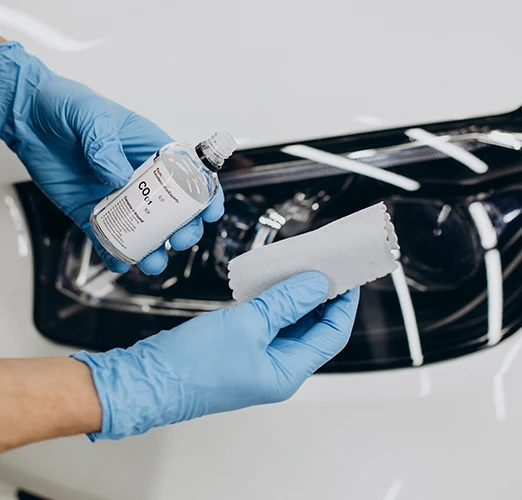When it comes to car care and protection, one of the most talked-about advancements in automotive detailing is the Car Ceramic Coating. It’s widely known for its ability to enhance a car’s appearance, add gloss, and provide a layer of protection against environmental contaminants. But among all the benefits it offers, one common question that car owners often ask is: Will ceramic coating prevent water spots?
To answer that question thoroughly, we must dive into how ceramic coatings work, what causes water spots, and the role of مخفي العازل الحراري in car protection. In this article, we’ll explore whether ceramic coatings are the ultimate solution to water spots and what you can do to minimize them effectively.
What Is a Ceramic Coating?
Car Ceramic Coating is a liquid polymer that is applied to the exterior surfaces of a vehicle. Once cured, it chemically bonds with the vehicle’s factory paint, creating a protective layer on top. This layer is hydrophobic, meaning it repels water, and it offers resistance to UV rays, chemicals, dirt, and minor scratches.
Ceramic coatings are not waxes or sealants; they are much more durable and long-lasting, often lasting up to 2-5 years depending on the quality of the coating and how well it's maintained.
What Are Water Spots?
Before diving into the preventive aspect of ceramic coatings, let’s understand what water spots really are.
Types of Water Spots
Water spots occur when water evaporates from your car’s surface and leaves behind mineral deposits, typically calcium and magnesium. These spots can come from various sources:
- Tap water used during washing
- Rainwater containing airborne pollutants
- Sprinklers or hard water sources
There are two main types of water spots:
- Mineral Deposits (Type I): These are the most common and appear as cloudy, white rings. They're caused by hard water that dries on the surface.
- Etching (Type II): These occur when mineral deposits sit too long on a surface and start to etch into the clear coat or coating layer, causing permanent damage.
Does Ceramic Coating Prevent Water Spots?
Now to the heart of the matter—can Car Ceramic Coating stop these pesky water spots?
The Hydrophobic Advantage
One of the key selling points of ceramic coatings is their hydrophobic nature. When water hits a ceramic-coated surface, it beads up and rolls off more easily than on untreated paint. This reduces the chance of water drying on the surface and leaving behind minerals.
However, Car Ceramic Coating does not completely prevent water spots. It only makes it harder for them to form.
Why Water Spots Still Happen
While ceramic coatings repel water effectively, any residual water left on the surface can still evaporate and leave behind minerals. The coating makes it easier to clean these spots off before they cause damage, but if left unattended, they can still form and even etch into the ceramic layer itself.
Misconceptions About Ceramic Coatings
Many people assume that applying a ceramic coating means their car is now “maintenance-free.” This is one of the biggest myths. While coatings reduce maintenance, they do not eliminate it.
Ceramic Coating Is Not a Force Field
A Car Ceramic Coating does not make your car invincible. It offers a sacrificial layer of protection, which means it's designed to take the brunt of environmental attacks—like bird droppings, tree sap, UV rays, and yes, even water spots. But over time, this coating can degrade and will require maintenance.
How to Reduce Water Spots on Ceramic Coated Cars
Now that we know ceramic coatings can’t fully prevent water spots, here are several tips you can follow to minimize their occurrence:
1. Use Filtered or Deionized Water
Using hard tap water to wash your car increases the risk of water spots. Invest in a water filtration or deionization system to eliminate minerals from your water source.
2. Dry Your Car Immediately
After washing or rainfall, drying your car quickly and thoroughly using a microfiber towel or air blower will prevent water from sitting and evaporating on the surface.
3. Apply a SiO2 Topper
To boost the effectiveness of your Car Ceramic Coating, apply a silicon dioxide (SiO2) spray topper. These help maintain hydrophobicity and add another layer of protection against mineral deposits.
4. Use مخفي العازل الحراري for Full Protection
Adding مخفي العازل الحراري (heat insulation film) to your vehicle, especially on glass surfaces, can reduce heat buildup and minimize water spot etching. While it's commonly used for its heat-blocking properties, it also contributes to the overall preservation of your vehicle’s finish.
5. Wash Regularly
Even with a ceramic coating, you should stick to a regular wash schedule. Leaving dirt and minerals to sit on your car for too long increases the risk of etching and spotting.
What to Do if Water Spots Form on Ceramic Coating
Despite your best efforts, you might still find the occasional water spot. Here's how to deal with it:
1. Quick Detailer Spray
If the water spots are fresh, a simple quick detailer spray and microfiber towel can remove them easily without harming the coating.
2. Vinegar Solution
For more stubborn spots, a diluted white vinegar solution (1:1 with water) can help dissolve mineral deposits. Be sure to rinse thoroughly after using it.
3. Water Spot Remover
There are specialized water spot removers designed for use on ceramic-coated vehicles. Choose a pH-balanced, coating-safe formula.
4. Professional Maintenance
If etching has already occurred, you may need a professional to do a light polish and reapply a portion of the ceramic coating to restore full protection.
Additional Benefits of Ceramic Coating
While water spot prevention isn’t 100% foolproof, there are other compelling reasons to choose a Car Ceramic Coating:
- UV Protection: Prevents oxidation and fading of paint.
- Chemical Resistance: Shields against acidic contaminants.
- Ease of Cleaning: Dirt and grime slide off more easily.
- Glossy Finish: Enhances the paint’s depth and shine.
- Long-Term Value: Preserves your vehicle’s appearance, boosting resale value.
How مخفي العازل الحراري Complements Ceramic Coating
مخفي العازل الحراري and ceramic coatings serve different purposes but together provide a comprehensive protective system. While ceramic coatings protect the paint surface, مخفي العازل الحراري is ideal for windows and windshields, reducing solar heat, glare, and UV exposure inside the cabin.
Additionally, the less heat your vehicle retains, the less likely minerals are to bake into the surface when water dries. In that sense, مخفي العازل الحراري indirectly helps reduce the severity of water spot etching—especially in hot climates.
Final Thoughts
So, will ceramic coating prevent water spots? The answer is: not entirely. While Car Ceramic Coating offers excellent hydrophobic properties that reduce the chances of water spots forming, it is not a magical shield against them. Proper maintenance, careful washing techniques, and combining your ceramic coating with مخفي العازل الحراري will go a long way in protecting your vehicle and preserving its pristine look.
Ceramic coatings are a smart investment for car enthusiasts and everyday drivers alike. But as with any protective solution, understanding its limitations and supporting it with good practices will give you the best results. Stay proactive with your car care, and you'll enjoy a cleaner, glossier, and more resilient ride for years to come.


